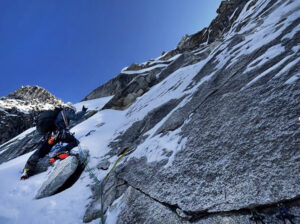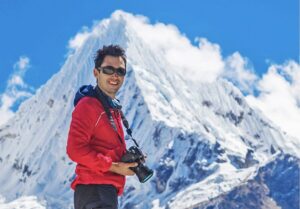Mountains can be holy places, venerated by cultures both old and new. They emerge proudly, they shelter plants, animals, and spirits.
We have previously written about the sacred peak Kawagarbo in Yunnan, China. This article will explore more mountains that feature local beliefs and deities. Geography, history, culture, religion, superstition, and mountaineering all converge on these mythical peaks.

Shambhala. The hidden kingdom. Painting: Nikolai Roerich
Mount Olympus
The highest mountain in Greece creates a natural division between Macedonia and Thessaly. Since the time of the ancient Greeks, the mountain was considered the abode of the gods. Locals believed that humans could not access their deities’ ice palaces at the top of the mountain.
Even Alexander the Great visited this historical peak when he arrived in the city of Dion, at the foot of Olympus.

Mount Olympus. Photo: Ayer y Hoy
The highest peak of Olympus, Mytikas, measures 2,917m. In 1913, a three-man team did the first recorded ascent. Two Swiss — photographer Francois-Frederic Boissonnas and art historian Daniel Baud-Bovy — accompanied a Greek guide and hunter named Christos Kakkalos. Kakkalos climbed barefoot.
In stormy weather, the men became confused and reached a point that they believed was the highest. But once the sky cleared, they realized that there was another higher peak, which they would have to access via a slippery corridor. They finally managed to reach the summit on August 2, 1913.
Khan Tengri

Khan Tengri. Photo: Paco Crestas
This 7,010m peak’s classic shape reinforces its cultural divinity. Located in the Tian Shan mountains on the border of China, Kyrgyzstan, and Kazakhstan, its name means King of Heaven or King of the Sky. This refers to the god Tengri. Tengri is a divine figure of the ancestral religion of Tengrianism, typical of the Turkic, Mongol, Hun, Magyar, and other small ethnic groups originating from the steppes of Central Asia.
Tengrianism is based on popular shamanism. Its main gods are the Sky Father and the Earth Mother. According to this religion, the world was created using earth, water, fire, and air. Interestingly, in some languages, such as Hungarian, the word Tengri has come to mean “sea”.
The locals call this peak Kan-Too, coming from Turkish, which roughly translates to Blood Mountain.
Khan Tengri is difficult to climb because of frequent massive avalanches, falling seracs, and changeable weather. The famous Kazakh climber, Anatoli Boukreev, declared it the most beautiful mountain on the planet.

An avalanche close to the base camp of Khan Tengri. Photo: Curro Gonzalez
Until 1943, Khan Tengri was considered the highest mountain in its range, but Pobeda Peak is higher. Mikhail Pogrebetsky, Franz Zaubrer, and Boris Tyurin first climbed Khan Tengri on September 11, 1931. They did not have a map of the mountain but only information from two reconnaissance trips made two years earlier.
At first, the team wanted to climb the northwest ridge. But strong winds forced them to turn to the western slope. They climbed through difficult snowy corridors until they finally summited.
Otgon Tenger

Otgon Tenger. Photo: Rally for Rangers
This 4,008m peak is the highest mountain in Mongolia’s Khangai Mountains and the only one with a glacier. Otgon Tenger means “The Youngest Sky” and also alludes to the god Tengri. But the mountain is also sacred for Buddhists.
According to legend, a furious deity lives at the top of the mountain. Ochirvaani, also known as Vajrapaani, wields a thunderbolt in his hand. According to tradition, his name should never be pronounced, so they call him Kahirkhan, which means “Loving King”.
Despite its modest altitude, Otgon Tenger’s 2,200m prominence is striking. Its southern face features the largest granite wall in Mongolia.
In 2015, the Mongolian authorities prohibited climbing on the mountain because of the high risk of avalanches. The ban was extended to protect the area roundabout, which is full of ovoos — stone mounds that are a type of shamanic cairn made of rocks or wood. These are generally built on mountain passes or the upper part of mountains to honor the mountains and the sky.
The mountain has been the scene of several tragedies. On October 22, 2017, several groups of mountaineers ignored the rules and decided to climb. During their descent, a huge avalanche struck, killing 17.
Then on August 4, 1963, a Mongolian Airlines plane crashed into the peak, with no survivors.
Otgon Tenger is not the only sacred mountain in Mongolia. Others include Burkhan Khaldun and Asralt Khairkhan.
Ol Doinyo Lengai

Ol Doinyo Lengai. Photo: Martin Rietze
Ol Doinyo Lengai is an active stratovolcano in northeastern Tanzania. It measures 2,962m and is the only volcano that expels lava consisting of a type of rock called carbonatite. This lava is very fluid and relatively cool, reaching a temperature of “only” 590°C (normal lava would be a minimum of 900°C). When it flows as lava, it is black, but when it cools or comes into contact with water, it turns white. At night, it photographs deep red.

Ol Doinyo Lengai. Photo: Michael Greshko
It has two craters, north, and south. Only the north crater is active. In the language of the Maasai people, the name means the “Mountain of God”.
Curiously, you are allowed to climb this volcano. It takes about eight hours to ascend, so most climbers start around midnight.
Six years ago, 15km from the volcano, a team of researchers found more than 400 human footprints in the mud that were between 19,000 and 6,000 years old. No other place in Africa has as many traces of Homo sapiens as this modest-sized place, no bigger than a tennis court.
The tracks show that people were running, and scientists can even determine their speed. It seems that most of them were women and children heading southwest.
Belukha

Mount Belukha. Photo: Peakvisor
At 4,506m, Mount Belukha is the highest peak in both the Altai and the highest in the South Siberian Mountains. It borders Russia and Kazakhstan and is just a few kilometres from China. Traditionally, the peak was named Uch-Sumer, which means “Three Peaks” or “Three-Headed Mountain”. Belukha means “white”.
Some people believe that Belukha is the entrance to Shambhala, a mythical realm beyond the Himalaya. Many also come to meditate at its foot, trying to communicate with the spirits.
The Altaians believe that the goddess Umai, the most important deity for Turkic people, lives on this mountain. Umai is the patron of mothers and helps in childbirth.

Mount Belukha. Photo: Wikipedia
Of the mountain’s several peaks, the two main ones — Eastern Belukha (4,506m) and Western Belukha (4,435m) — look like irregular pyramids. The eastern summit is easier to access and so climbers attempt it more often. A third peak, Delaunay, is 4,260m high.
The first attempt to climb Belukha took place in 1897, by Russian scientist Vasiliy Sapozhnikov. Two more failed attempts occurred before the brothers Mikhail and Boris Tronov finally climbed it on July 25, 1914.
Nevado Ausangate

Nevado Ausangate is an Apu, a sacred mountain for the Inca. Photo: Mono Andes
The fifth highest mountain in Peru, Nevado de Ausangate (6,384m) had great importance to the Inca culture. For them, Ausangate was an unattainable god.
An Austro-German expedition consisting of Fritz Marz, Jurgen Wellenkamp, Heinz Steinmetz, and Heinrich Harrer (of Seven Years in Tibet fame) first climbed it on July 24, 1953.
Its spectacular north and south faces feature many still-unclimbed lines. Visitors also speak of its sunrises and sunsets and its turquoise alpine lakes that mirror the sky.
In the Andes, the word “Apu” refers to spirits that live in the mountains. Pre-Inca cultures also viewed mountains as the residence or embodiment of deities.

Nevado Ausangate. Photo: Inkayniperutours






